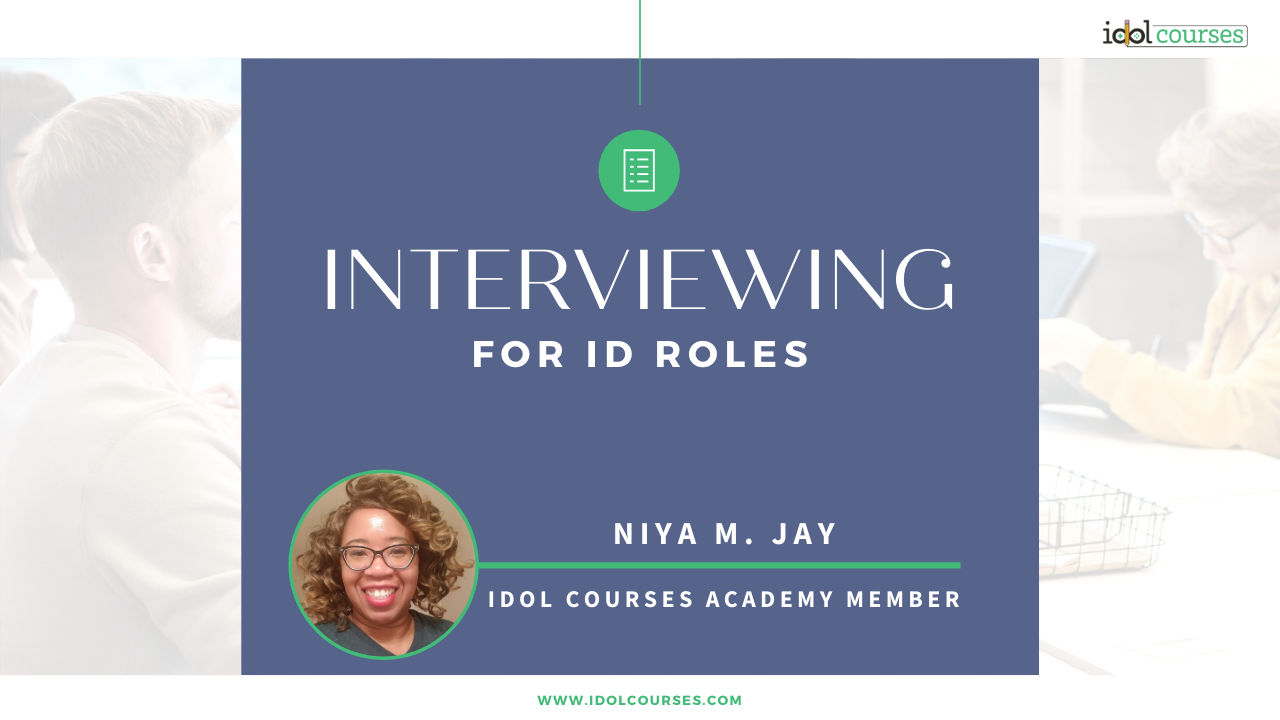Interviewing for Instructional Design Roles
Oct 01, 2020
Now navigating the Interviewing process for ID roles can become a slippery slope, but before you interview, know what you want: What salary are you looking for? What about the people you will be working with? Is the position remote? Do you need health benefits or PTO?
I use a backwards design model to Interview for ID roles. Backward design is starting with the goal then working backward to achieve it. I look at the interviews with the end in mind. It's not enough to know you want a job in ID, but know precisely what you want in that job. At first, I didn't know exactly what I wanted. I was excitedly applying for my first ID job, and I was contacted by a recruiter for a corporate training position at a major bank; I thought WOW!! I would be doing some ID work, but for the most part, it would be instructor-led training. It was a Webex interview. The person I was interviewing with was very stern, the position didn't feel like a good fit. This was my first ID interview, and it was the longest 30 minutes of my life; Now four interviews later.
I want to share five tips for ID Interview success:
- Know what you want. Know yourself and know the expectations for your next career opportunity.
- Have a redirection strategy. Know that rejection is simply redirection, but have a strategy to deal with it because redirection will happen.
- Interviewing works both ways. Just like the company is interviewing you, you are interviewing the company to make sure it's the right fit. Think about this, are you looking for a job to pay the bills, or are you looking for your next career?
- Speak to your portfolio. You should be able to showcase your portfolio and talk about your design process when interviewing. Brag on your assets and how you designed and developed them.
- Don't just tell the employer your skills and qualifications. Tell them how you can solve a dilemma or be an asset to the organization.
- Send a Thank-you email.
In conclusion, I have learned alot about myself and my expectations for my first ID role. I want a financially stable career with a company that allows me to explore my creativity with endless growth and personal development opportunities. I want to be a full-time Instructional Designer, and I want to be treated like a professional, not micromanaged. My redirection strategy is after applying to ten jobs take a break from applying and follow up on the jobs previously applied too.
Be prepared to ask the company questions. An example of my top question is what are the 30. 60. 90 day expectations for the person in this role. I get insight on the job, but I also get a feel for the day in the life for the employee. I struggled at first to explain my portfolio because I don't often get to brag; but after my first attempt I was excited to share my process of how my portfolio came to life and my design process. Brag on your accomplishments and highlight what makes you unique. Companies want to know how you will help them be better through increasing profits or improving productivity. You may be the only L&D person so the company may need perspective on what implementing e-learning means. I have been praised often for sending a Thank-you email to the person I interviewed with. The email should highlight some of the aspects you liked about the company and a few takeaways about the position and thank them for their time. In this virtual climate, thinking someone for their time is priceless.
Written by: Niya M. Jay, MBA
Niya is an Instructional Designer and former public educator. Combined, she has over seven years of experience in learning and development. She considers her niche designing dynamic courses that improve business functions and is always looking for opportunities to grow and develop her skills.Work-life balance is important to her career success. She enjoys HITT cardio, reading, cooking, traveling internationally and family time when she is not working. Check out her portfolio.
Stay connected with news and updates!
Join our mailing list to receive the latest news and updates from our team.
Don't worry, your information will not be shared.
We hate SPAM. We will never sell your information, for any reason.


